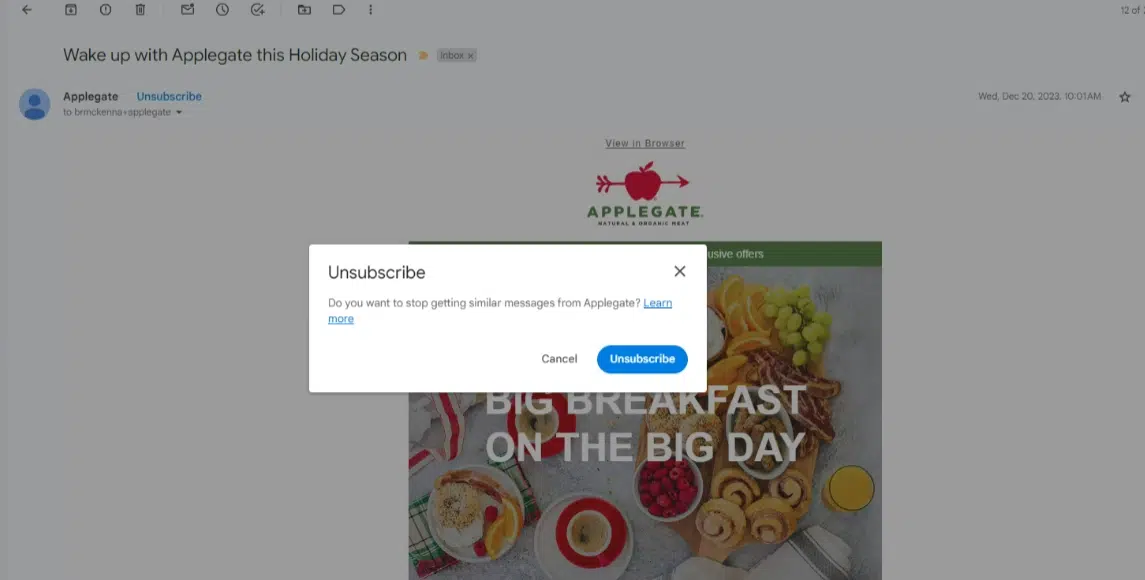Gmail spam updates are here: What now?
Gmail is cracking down on bulk emailers who send over 5,000 emails per day. Learn what's changing and how to avoid the spam folder.
Starting in April, Google will enforce new rules for brands sending over 5,000 emails daily to Gmail addresses. The goal is to cut down on spam by enforcing specific requirements around authentication, ease of unsubscribing and relevancy of messaging.
For marketers relying heavily on email campaigns and communications, this policy will require quick action to ensure deliverability doesn’t take a hit.
What this means for bulk email senders
Google already regularly sends some emails to the spam folder. The recent updates explain why and give tips to brands on how they can prevent it from happening in the future.
To avoid ending up in spam folders, remember these three things:
- Set up specific authentication factors.
- Give people an easy way to unsubscribe.
- Don’t be sketchy. (Don’t misrepresent who you are or why you’re sending the email, and don‘t bombard your users.)
The second point is relatively tricky to update — but shouldn’t be too complicated. In a perfect world, brands would make unsubscribing this easy and obvious:


How brands should take action
The good news is that brands who have generally stayed out of spam filters probably won’t have a whole lot to update as far as email functionality goes (except maybe coding in the unsubscribe function at the top of the emails, as shown above).
But Google is also providing more explicit sender guidelines that cite a spam rate of .03% (or 3 out of every 1,000 emails) as a threshold for brands to avoid.
- If you aren’t sure of your spam rate, set up and reference Google Postmaster tools to see your current spam levels.
- If you’re hovering around .01% or lower, you’re probably already doing what I’m about to recommend.
- If you’re over .01% — and especially if you’re over .03% — do the following immediately:
Narrow your email sends
For the time being, send only to your active and loyal users. Pause sends for segments of users who haven’t opened or clicked on your emails within certain time frames (e.g., three or six months).
Before you reactivate sends to those users, make sure you’ve got clean and strategic audience segments built out, including a re-engagement segment for folks who have gone quiet and need different messaging. Note that Gmail/Google won’t necessarily flag when people manually mark your emails as spam, so this step is an important one.
Audit your messaging
Make sure it’s relevant to each segment. Don’t just go broad with your messaging.
Set up for personalization and incorporate recent user actions. In other words, if you don’t want to be marked as spam, don’t spam all users with the same content.
Tailor engagement based on acquisition source
For new-user acquisition and onboarding, consider tailoring your engagement thresholds differently based on the acquisition source.
- For instance, you should have a longer leash for consistent communication for users who came to your site organically and expressed a level of purchase intent.
- In contrast, if a limited-time campaign (e.g., sweepstakes or unusual promotions) brings in new users, you should set up notifications to pull people much sooner.
Dig deeper: New rules for bulk email senders from Google, Yahoo: What you need to know
What happens if you don’t heed Google’s requirements?
Google’s unclear about any penalties, but my experience tells me that getting flagged for email spam is a lot like getting penalized for violations of the search algorithm. I won’t be a death sentence, but you’ll have to go through a vague, painful remediation process to get back in Google’s good graces.
Ultimately, this is one step in what I imagine will be a series of spam-reducing initiatives since it’s in Google’s best interest to create a good user experience. Open and click rates are — and will become — harder to measure due to iOS 15 and 17. As such, the important takeaway here is that it’s imperative to understand who your loyal subscribers are and to manage communications accordingly.
Consider this a bit of a warning from Google to set up whatever is needed in your back end to identify those users and make sure you’re taking a tailored approach for each segment. More than keeping you out of spam folders, it should help you put your best foot forward to engage your full user base effectively.
Opinions expressed in this article are those of the guest author and not necessarily MarTech. Staff authors are listed here.
Related stories